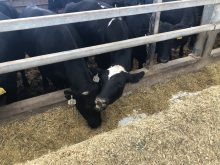Striped species has always had a natural ability to tolerate neonics, but the insecticide remains effective against crucifers
WINNIPEG — Many generations of flea beetles have been exposed to neonicotinoids in Western Canada over the last two decades.
Farmers across the Prairies plant 20 million acres of canola and most of the seeds, year after year, have been coated with neonicotinoid insecticides, commonly known as neonics.
From 2017 to 2022, there were many reports of severe flea beetle infestations on the Prairies despite the use of those seed treatments.
Read Also

New coal mine proposal met with old concerns
A smaller version of the previously rejected Grassy Mountain coal mine project in Crowsnest Pass is back on the table, and the Livingstone Landowners Group continues to voice concerns about the environmental risks.
That led researchers to wonder whether chronic use of neonics caused a change in flea beetles so they are resistant to the pesticide.
“The answer is possibly, but we don’t know for sure … No one has actually looked for the mutations in the flea beetles to see if they have that ability to overcome the insecticides,” said Krista Anderson, an agronomic adviser with Bayer CropScience Canada, in 2022.
Boyd Mori, an entomologist with the University of Alberta, has been trying to answer that question for the last couple of years.
He doesn’t have a definite answer yet, as his study will continue for another year. But it seems that neonic seed treatments are still effective against the beetles, which feed on emerging canola plants in late May and in June.
“We have some preliminary results,” said Mori, who explained that two types of flea beetles cause most of the damage in canola fields — crucifers and striped.
“The crucifers — it still seems to work pretty well on crucifers. (But) we do see a reduced mortality in the striped flea beetles when feeding on canola seedlings treated with a neonicotinoid.”
The result for striped flea beetles isn’t a surprise. Research from more than 15 years ago also found that neonics are less effective against that species.
“We don’t even call it resistance in flea beetles,” Mori said in 2022. “The striped flea beetles already have a natural mechanism … that helps them tolerate the neonicotinoids.”
Results Driven Agriculture Research, the Alberta Canola Producers Commission, the Western Grains Research Foundation, Bayer and Syngenta provided funds for this project.
Mori’s conclusions will be reported after this year. In the meantime, he’s also studying foliar insecticides used to kill beetles in canola.
Similar to the neonic research, Mori has determined that synthetic pyrethroids (a class of insecticides) are still effective.
“We’ve tested populations in Saskatchewan and Alberta,” he said. “So far, our (research)… has shown that those synthetic pyrethroids continue to work and should be working against our flea beetle populations.”
He and his colleagues still need to test flea beetles in Manitoba to understand if there’s resistance to foliar insecticides on the eastern Prairies.
In yet another study on flea beetles, Mori is trying to understand whether beetles across the Prairies are genetically the same or genetically distinct.
“Canola is grown widely across the Prairies but there are different micro-climates across the region,” he explained.
As an example, the flea beetles in the warm and humid climate of southern Manitoba could be genetically different from the population in northern Alberta.
Answering the genetic diversity question could be useful because a control strategy that works on flea beetles near Vegreville, Alta., may not work in Winkler, Man.
“Most likely … it’s going to be choice of insecticide, if we do see that populations in some regions are responding differently to insecticides,” Mori said.
The research will look at flea beetles across the wide geography of Western Canada, but also at a local scale. Mori wants to know if flea beetles collected from a particular canola field are the same as those in a field that’s 10 or 25 kilometres away.
Also, are beetles in the canola crop different from the ones in a nearby ditch?
“We’re collecting flea beetles in field and then adjacent to the field, in wheat, or weeds, or volunteer canola,” he said. “We presume the flea beetles we find on the weeds… will be the same ones we find in the canola. But we’re not sure.”


















